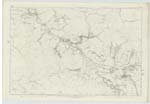OS1/3/21/72
| List of names as written | Various modes of spelling | Authorities for spelling | Situation | Description remarks |
|---|---|---|---|---|
| DAME HELEN'S CASTLE | Dame Helen's Castle Dame Helen's Castle Dame Helen's Castle Dame Helen's Castle Dame Helen's Castle Dame Helens Cas. [Castle] |
- William Walker Esqr Revd. [Reverend] William Gilchrist P. M. [Parish Minister] Mr. William G Galloway P. S. [Parish Schoolmaster] Mr. Robert Smith Merchant Johnston's County Map |
046 | The Site of an old building level with the ground and covered over with [grass] pointed out by the villagers as a Castle built and occupied by 'Dame Helen', and from whom the village [gets] its name. It Stands on a Small round Knoll about 40 feet above the bed of the Muck Water, defended by a dry fosse of about 8 feet wide and about as many deep the recent new road through it has taken away the most of this ditch little or nothing remains but the tract of the Castle it is not Known when it was built nor [whend demolished] but the most of the Stones in the house Called 'Castle House' was taken from there property of the Hone. [Honourable] F M Cathcart Berbeth |
Continued entries/extra info
[Page] 72Dalmellington Parish -- Sheet 46 - 16
Extract from Patterson's History of Ayrshire;-
"The castle belonging to Dame Helen, from whom the burgh
" is said to have derived its name, stood a few hundred yards above
" Dalmellington, on a green knoll, surrounded by a fosse. **
"The Castle evidently had been a small one, and perhaps circular. With
"respect to its age, there is some reason to believe that it was amongst the
"oldest in Scotland. 'One of the oldest houses in the village', says the
"New Statistical Account, 'from having been built of the materials
"of the castle, is called the Castle House; and one of its door lintels
" bore, thirty years ago, the date 1003' - This would carry the building
"back fifty four years before the accession of Malcolm Canmore, when no
"castle existed. There must be some mistake we should think, on the part
"of the writer in the Statistical Account. When in Dalmellington the
"Castle House was pointed out to us, and on the lintel of one of the
"doors, an antique looking stone, we could trace the figures, though
" greatly defaced, '1115' - thus bringing the date of the castle down more
"than a century. This would agree perfectly with what is called by Chalmers
"the Scoto-Saxon period of our history, when so many grants of land were
"bestowed upon foreigners - when castles began to be built, the feudal system to usurp the patriarchal."
Transcribers who have contributed to this page.
Chr1smac -Moderator, hillhere
Location information for this page.
Linked mapsheets.




